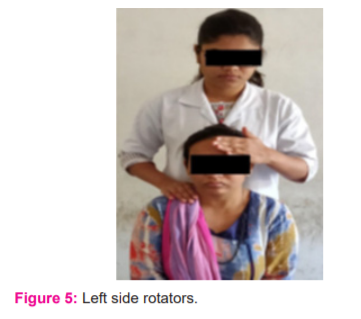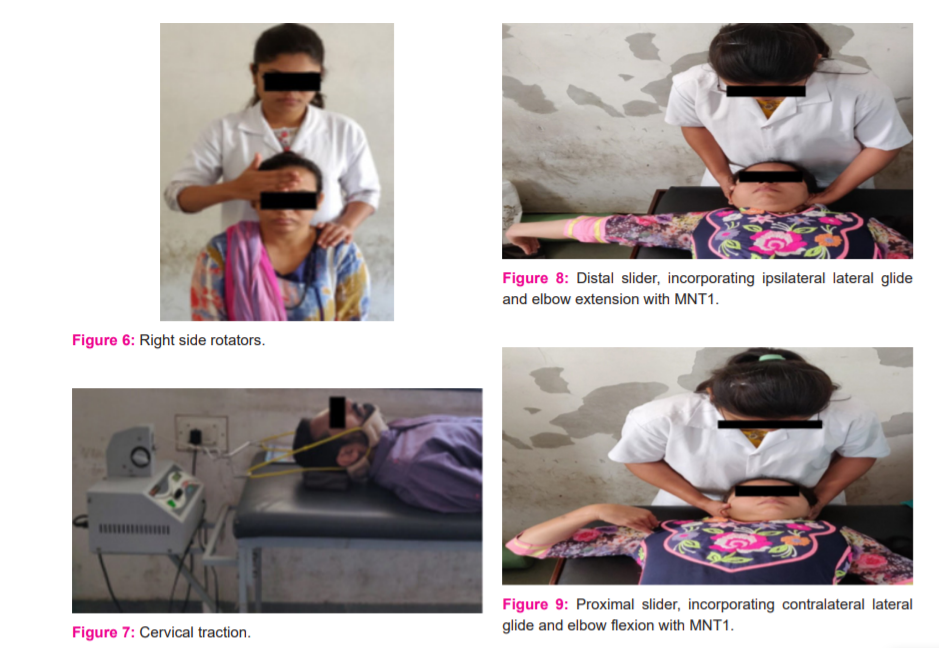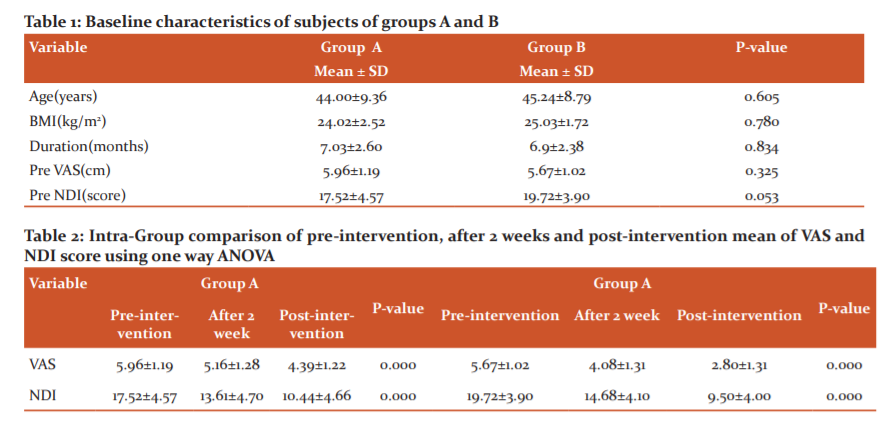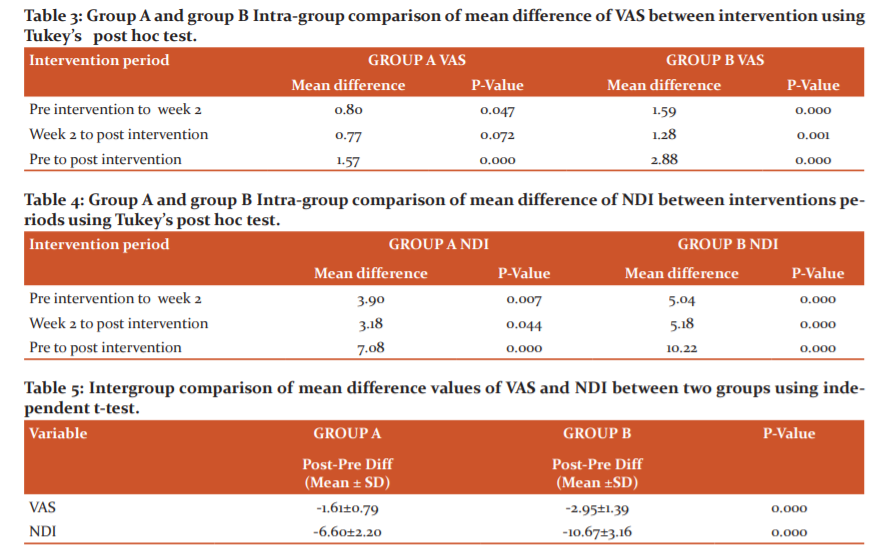IJCRR - 13(15), August, 2021
Pages: 81-88
Date of Publication: 10-Aug-2021
Print Article
Download XML Download PDF
\"Effect of Two Ended Slider Neurodynamic Technique on Pain and Disability in Patients with Cervical Radiculopathy\" - An Experimental Study
Author: Gamit Himani, Hingarajia Dharti
Category: Healthcare
Abstract:Introduction: Cervical radiculopathy (CR) is a dysfunction of a nerve root in the cervical spine, is a broad disorder with several mechanisms of pathology. The average annual age-adjusted incidence rate of CR is 83/ 100,000 for the population in its entirety. There is a paucity of literature about the effectiveness of two ended slider Neurodynamic technique in CR. Objective: To compare the effect of two ended slider Neurodynamic technique along with conventional physiotherapy and conventional physiotherapy alone in patients with CR. METHODS: Total 58 patients included. Patients were evaluated before, after 2 weeks and post intervention for pain intensity and disability. Data were statistically analyzed at the significance level of < 0.05 using SPSS 15 version. Both groups (control and experimental) received conventional physiotherapy, in addition, the experimental group also received two ended Neurodynamic techniques. Results: One way ANOVA test applied for intragroup comparison and there were statistically significant differences in mean VAS and NDI in both the groups during 4-week intervention. An Independent t-test was applied between-group comparisons and there was statistically significant differences between the control group and experimental group in a mean difference of VAS and NDI during 4-week intervention. Conclusion: Conventional physiotherapy and two ended slider neurodynamic technique along with conventional physiotherapy is effective for improving pain and reducing disability. However, two ended slider neurodynamic technique along with conventional physiotherapy is more effective for reducing pain and disability in patients with CR.
Keywords: Neck Disability index (NDI), Visual Analogue Scale (VAS), Cervical Radiculopathy (CR), Median Neurodynamic Test (MNT), Nerve Mobilization (NM), Cervical Nerve Roots (CNRs)
Full Text:
INTRODUCTION
Cervical Radiculopathy is a peripheral nervous system disorder affecting the normal function of Cervical Nerve Roots and is often associated with chronic pain and functional limitations in daily life.1,2,3,4,5 Mostly Result of a compressive or inflammatory pathology from disc herniation, spondylitis spur or cervical osteophytes resulting from inflammation of CNRs.6
Clinical signs and symptoms of cervical radiculopathy include numbness, tingling, pins & needle, radiating, shooting pain along the nerve root distribution7& also triggered by additional stress on weakened core muscles of spine structures. 8,9,10
The average annual age-adjusted incidence rate of CR is 83/100,000 (107.3 for men and 63.5 for women) for the population in its entirety with the peak incidence in the 5th and 6th decade (203 per 1000) in both genders has been reported.8 It's estimated 50% of the population will experience neck and upper extremity pain.11 Epidemiological research studies notify annual prevalence between 15%- 50%.9, 12, 13, 14
Conservative treatment for CR typically includes therapeutic exercise (ROM, strengthening), manual therapy (NM, non-thrust mobilization etc.), modalities (Heat & cold therapy, traction, TENS) cervical collar etc.15, 16, 17, 18, 19
Pain is typically generated when microvascular alterations result of compression lead to up-regulation of inflammatory mediators ultimately lead to adhesions between herniated disc & nerve root will impair gliding of the nerve root.20
Radicular pain is not always associated with vertebral or intervertebral pathology but the decrease in excursion of the nerve is another cause of radicular symptoms which is not purely based on the nerve root.21 This suggests mobilizing neural course is not enough at root level but the sliding pattern of the neural pathway concerning surrounding soft tissues or relation inter neural tissues is required.
Neurodynamics based on the biomechanical structure of peripheral nerves& a set of techniques designed to restore plasticity of the nervous system.22 There are two types of neurodynamic techniques i.e. tensioners (i.e. produce increase tension in neural structures) and sliders (i.e. produce a sliding movement of neural structures relative to their adjacent tissues & based on the neural excursion). There are two types of sliders i.e. one ended as moves the neural structures with the use of body movements at one end of the neural system and two-ended slider as applying tension at one end of the nervous system whilst letting it go at the other.23
Although the literature supports the utilization of NM in the treatment of CR and other conditions, only a few have especially utilized two ended slider nerve mobilization. There are currently a lacks good-quality studies in the literature that describe the use of two ended slider neurodynamic and the literature is also limited due to a detailed description of this technique performed. And so, the potency of this intervention is needed to know the effect of two ended slider neurodynamic technique.
MATERIALS AND METHODS:
-
Number of subjects: 58
Based on the pilot study, the calculated effect size was 0.82. Sample size calculated in G power 3.1.9.2. Power was kept at 80, α was selected at 0.05, and the level of significance was 95%. The sample size calculated from these parameters was 48. With drop out chances of 20%, 29 subjects in each group.
-
Number of Group A. Control Group
B. Experimental Group
3. Study Design: Pre - Post experimental design
4. Population: Patients with cervical radiculopathy
5. Sampling Technique: Purposive sampling
6. Study Duration:1 year
7. Inclusion Criteria:
-
Subjects were diagnosed with CR by orthopaedicdic Surgeon.
-
Age between 30 to 60 years
-
having pain for >3 months
-
Below elbow radiating pain in one upper extremity
-
positive Median Neurodynamic test 1(MNT1)23
-
Ethical clearance ref. No. : EC/SPB/018
8. Exclusion Criteria:
-
Traumatic injuries/other musculoskeletal disorders of the upper extremity and cervical spine within 6 months
-
Dizziness, asymptomatic for pain but symptomatic for tingling and paraesthesia
-
Circulatory disturbances of upper extremity
-
Known history of high-level spinal cord injury
-
peripheral nerve injury, neuropathy and Malignancy
-
Severe Osteoporosis, Canal stenosis and cord compression
-
Cervical instability, Hypermobility, Vertebrobasilar insufficiency
-
Spondylolysis and spondylolisthesis, Rheumatoid arthritis
-
The person currently taking medication
9. Materials & Tools:
-
Pen, Paper, Plinth, Stool, Mechanical traction unit, Neck disability index, Visual analogue scale, Stadiometer, Weighing machine
10. Outcome Measures:
-
Pain measured in a 10 cm Visual Analogue scale.24 VAS is a 10 cm line with pain descriptors marked “no pain” at one end and “the worst pain imaginable” at the other. Patients were asked to mark which best suits their pain level at rest.
-
Disability measured by the NDI scale.25 NDI scale is a questionnaire designed to better understand how neck pain affects the ability to manage everyday life activities. Patients were instructed to answer every section and in each section only the one box which applied to them.
11. Procedure:
-
Ethical clearance was taken from the institutional ethical committee. Subjects were preliminary screened based on the inclusion and exclusion criteria. The purpose of the study was explained and written informed consent and demographic details were obtained from all the subjects. They were randomly allocated into two groups by the sealed envelope method.
-
The procedure of blinding: Subjects were blinded on either type of intervention and to which group they belonged. Throughout the treatment sessions, subjects from both groups were not allowed to have any interaction with each other and subjects were not aware of what kind of treatment they received and its effects.
-
Descriptions of groups are Group A: Conventional physiotherapy and Group B: Two ended slider neurodynamic technique + Conventional physiotherapy.
GROUP A (CONTROL GROUP):
-
ISOMETRIC EXERCISES OF CERVICAL MOTIONS:
-
Total 10 repetitions with 10-sec hold were given of isometric exercises for each motion. 2 minutes rest period between each exercise sitting position with neck and back straight. Exercise for flexors, extensors, side flexors (left and right), lateral rotators (left and right) )(Figure 1 to 6)
-
CERVICAL TRACTION:
GROUP B (EXPERIMENTAL GROUP):
-
Receiving two ended slider neurodynamic technique and conventional physiotherapy
-
Two Ended Slider Neurodynamic Technique23: Total 3 sets of 6-8 repetitions were given in one set with 10 seconds rest in between sets for 10 minutes in each session for 3 days/week for 4 weeks.
-
Procedure: The patient was supine whilst the symptomatic upper limb was placed in the appropriate position for the relevant upper limb neurodynamic test (e.g. MNT1).
-
Starting position of MNT1 for two ended slider neurodynamic technique was shoulder 90° abduction.
-
The degrees of shoulder abduction and elbow extension is particularly important. In deciding on the extent to which the nerves are moved and was selected judiciously. The therapist position was standing at the head of the patient.
-
Step 1: The therapist had supported the patient's head and neck to be able to glide the patient's neck in an ipsilateral direction. The patient was asked to performed elbow extension whilst the therapist glides the head in the ipsilateral direction. (Figure 8)
-
Step 2: The therapist had supported the patient's head and neck to be able to glide the patient's neck in a contralateral direction. The patient was asked to performed elbow flexion whilst the therapist glides the head in the contralateral direction. (Figure 9)
STATISTICAL ANALYSIS
-
Statistical analysis was done using SPSS version 15.00 Software.
-
This study included AGE, GENDER, BMI, DURATION, VAS and NDI as quantitative variables. Shapiro-Wilk test was applied to check the normality of data. All quantitative data of this study follow the normality (p≥0.05). (Table 1)Baseline characteristics were compared to check homogeneity between intervention groups.
-
An Independent t-test was used for all the demographics and outcome measures like AGE, GENDER, BMI, DURATION, VAS and NDI before the training.
-
One way ANOVA was used to analyze the pre-intervention (week 0), after 2 weeks (week 2) and post-intervention (week 4) differences within each group and an independent t-test were used for between groups pre and post-intervention comparison. The confidence interval was kept at 95% and the level of significance for all statistical data was set at 0.05.
-
Lost to follow up 3 and 1 in group A at 2 weeks and 4 weeks and 4 and 1 in group B at 2 weeks and 4 weeks respectively. Total of 84 patients were assessed for eligibility. 58 patients were enrolled in the study and randomized to one of the treatment groups - 29 in group A and 29 in group B. Outcome measurements were completed on 49 participants (25 in group A and 24 in group B) after post-intervention. The baseline characteristics were similar between groups. All the parameters showed no significant difference (P>0.05) before intervention.
-
Both the groups were matched in terms of age, BMI, duration of symptoms, VAS and NDI before intervention. The baseline characteristics showed no statistically significant difference between the intervention groups before intervention. (P >0.05)
Intra Group Comparison of Two Outcome Measures (Table 2)
-
One way ANOVA was used to analyze the pre-intervention (week 0), after 2 weeks (week 2) and post-intervention (week 4) differences within each group for the mean values of outcome measure i.e. VAS and NDI within the groups. Result of the test that there is a significant difference between pre and post VAS in both the groups (p<0.05) and there is a significant difference between pre and post NDI in both the groups (p<0.05).
Group A And Group B Intra-Group Comparison Of Mean Difference Of Vas Between Intervention Periods Using Tukey’s Post Hoc Test(Table 3)
-
Tukey’s Post hoc test was done to know individual effects between pre-intervention to week 2, week 2 to post-intervention and pre-intervention to post-intervention for VAS. The result of Tukey's post hoc test suggests that there was a significant difference between pre-intervention to week 2 & pre-intervention to post-intervention and there was no significant difference between week 2 to post-intervention VAS in group A and there was a significant difference between pre-intervention to week 2 and week 2 to post-intervention & pre-intervention to post-intervention VAS in group B.
Group A And Group B Intra-Group Comparison Of Mean Difference Of NDI Between Intervention Periods Using Tukey’s Post Hoc Test(Table 4)
-
Tukey’s Post hoc test was done to know individual effects between pre-intervention to week 2, week 2 to post-intervention and pre-intervention to post-intervention for NDI. The result of Tukey's post hoc test suggests that there was a significant difference between pre-intervention to week 2, week 2 to post-intervention and pre-intervention to post-intervention NDI in both the groups.
Inter Group Comparison of Outcome Measures: (Table 5)
-
Intergroup comparison of mean difference values of VAS and NDI between two groups using independent t-test.
-
It was carried out to analyze is there any significance between the two groups and to find out the effectiveness to improve the pain and disability in cervical radiculopathy patients. There were significant differences were observed between the groups for both outcome measures (p<0.05).
DISCUSSION
-
The results of the present study indicates that intragroup comparison shows statistically significant differences in both the groups' post-intervention when compared to the pre-intervention mean of VAS and NDI during 4 week intervention period.
-
Intergroup comparison shows that there were statistically significant differences between groups in mean post-pre differences of VAS and NDI in patients with CR.
-
The possible mechanism for statistically significant improvement in pain intensity on VAS during 4 week intervention period in both the groups include to the physiological effect of isometric exercises on neural factors such as increases in activation of motor units acting synchronously and reducing or counteracting inhibitory impulses. The strong muscle contractions happen during isometric exercises which activate muscle stretch receptors which may cause endogenous opioids and also beta-endorphins to be released from the pituitary gland that may cause a decrease in pain.26
-
Pain may be also reduced by intermittent cervical traction which is given with neck isometric exercise in both groups. The possible mechanism of intermittent cervical traction (ICT)relieves the inflammatory reaction of nerve roots by improving the circulation to the tissues and reducing swelling of the tissues, gentle alteration of stretching and relaxation of the spasm of neck muscles and soft tissue structures that prevents the formation of adhesions of the Dural sleeve.27
-
In the experimental group (group B) there was a statistically significant improvement in pain intensity on visual analogue scale (VAS) and decrease in disability on the Neck disability index (NDI) After 4-week intervention compared to the control group.
-
This additional reduction of pain intensity is may be the effect of two ended slider neurodynamic techniques which were given additionally in the experimental group along with conventional physiotherapy.
-
Slider neurodynamics produces an opening action around the nerve root such as the dynamic and static opening of the bony and fascial interface (e.g. lateral glides) have been proposed for reduction of nerve root mechanosensitivity & the neurodynamic interventions may decrease intraneural pressure at the carpal tunnel, potentially relieving nerve hypoxia and reducing nerve pain symptoms. Neurodynamic interventions provide a peripheral stimulus that may interrupt the sensitization process through a peripheral effect. This neurophysiologic mechanism may also be related to the activation of descending inhibitory pathways.23,28
-
In both, the group's reduction of disability post-intervention compared to pre-intervention as measured by neck disability index was the reflection of reduction of pain.
-
There was a significant difference between the effect of two ended slider neurodynamic technique with conventional physiotherapy and conventional
Physiotherapy alone on pain and disability in patients with CR.
-
The present study reported that the experimental group (two ended slider neurodynamic technique + conventional physiotherapy) is more useful than the control group (conventional physiotherapy alone) for reducing pain and disability in patients with cervical radiculopathy.
-
Conclusion: Both the intervention techniques used in the present study i.e. conventional physiotherapy and two ended slider neurodynamic technique along with conventional physiotherapy are effective for improving pain and reducing disability. However, two ended slider neurodynamic technique along with conventional physiotherapy is more effective for reducing pain and disability in patients with cervical radiculopathy.
-
Limitation: Individual effect was not seen on either male or female. Quantitative outcome measures were not used in this study. The nerve mobilization treatment program was not specific to any single specific nerve. There was no long term follow up.
Acknowledgement
I would like to special gratitude thanks to my respected guide Dr. Dharti N. Hingarajia for proving her unwavering inspirational support, expert suggestions and wholehearted guidance and interest she showed in this research.
I will be failing in my duty if I do not thank all patients who participated in this study and spared their valuable time and made it successful.
I am also thankful for all physiotherapy journals where the idea of this research topic has arrived and also thankful to all HOD of physiotherapy OPD in Surat for permitting me to collect the data.
Conflict of interest: There was no conflict of interest
Financial support: There was no financial support






References:
-
Young IA, Cleland JA, Michener LA, Brown C. Reliability, construct validity, and responsiveness of the neck disability index, patient-specific functional scale, and numeric pain rating scale in patients with cervical radiculopathy. Am J Phar Med Res. 2010 Oct 1; 89(10):831-9.
-
Costello M. Treatment of a patient with cervical radiculopathy using thoracic spine thrust manipulation, soft tissue mobilization, and exercise. J Man Manip Ther. 2008 Jun 1; 16(3):129-35.
-
Thoomes EJ, Scholten-Peeters GG, de Boer AJ, Olsthoorn RA, Verkerk K, Lin C et al. Lack of uniform diagnostic criteria for cervical radiculopathy in conservative intervention studies: a systematic review. Eur Spine J. 2012 Aug; 21(8):1459-70.
-
Van Zundert J, Huntoon M, Patijn J, Lataster A, Mekhail N, Van Kleef M. Cervical radicular pain. Pain Practice. 2010 Jan; 10(1):1-7.
-
Thoomes EJ, Scholten-Peeters W, Koes B, Falla D, Verhagen AP. The effectiveness of conservative treatment for patients with cervical radiculopathy: a systematic review. Clin. J. Pain. 2013 Dec 1; 29(12):1073-86.
-
Langevin P, Roy JS, Desmeules F. Cervical radiculopathy: Study protocol of a randomised clinical trial evaluating the effect of mobilisations and exercises targeting the opening of intervertebral foramen [NCT01500044]. BMC Musculoskel Disord. 2012 Dec; 13(1):1-8.
-
Abbed KM, Coumans JV. Cervical radiculopathy: pathophysiology, presentation, and clinical evaluation. Neurosurgery. 2007 Jan 1; 60(suppl_1):S1-28.
-
Radhakrishnan K, Litchy WJ, O'fallon WM, Kurland LT. Epidemiology of cervical radiculopathy: a population-based study from Rochester, Minnesota, 1976 through 1990. Brain. 1994 Apr 1; 117(2):325-35.
-
Young IA, Michener LA, Cleland JA, Aguilera AJ, Snyder AR. Manual therapy, exercise, and traction for patients with cervical radiculopathy: a randomized clinical trial. Phys Ther. 2009 Jul 1; 89(7):632-42.
-
Fejer R, Kyvik KO, Hartvigsen J. The prevalence of neck pain in the world population: a systematic critical review of the literature. Eur Spine J.2006 Jun; 15(6):834-48.
-
Hult L. The Munkfors investigation: a study of the frequency and causes of the stiff neck-brachialgia and lumbago-sciatica syndromes, as well as observations on certain signs and symptoms from the dorsal spine and the joints of the extremities in industrial and forest workers. Acta Orthopaed Scandinavica. 1954 Aug 1; 25(sup16):3-76.
-
Hogg-Johnson S, Pierre Côté DC, Guzman J. The Burden and Determinants of Neck Pain in Whiplash-Associated Disorders after Traffic Collisions. Eur Spine J. 2008; 17(1):S52-9.
-
Strine TW, Hootman JM. US national prevalence and correlates of low back and neck pain among adults. Arthritis Care Res. 2007 May 15; 57(4):656-65.
-
Tampin B, Briffa NK, Goucke R, Slater H. Identification of neuropathic pain in patients with neck/upper limb pain: application of a grading system and screening tools. Pain. 2013 Dec 1; 154(12):2813-22.
-
Costello M. Treatment of a patient with cervical radiculopathy using thoracic spine thrust manipulation, soft tissue mobilization, and exercise. J Man Manip Ther. 2008 Jun 1; 16(3):129-35.
-
Cleland JA, Whitman JM, Fritz JM, Palmer JA. Manual physical therapy, cervical traction, and strengthening exercises in patients with cervical radiculopathy: a case series. J Ortho Spin Tech. 2005 Dec; 35(12):802-11..
-
Wainner RS, Gill H. Diagnosis and nonoperative management of cervical radiculopathy. J Oorth Pharma Tech. 2000 Dec; 30(12):728-44.
-
Waldrop MA. Diagnosis and treatment of cervical radiculopathy using a clinical prediction rule and a multimodal intervention approach: a case series. J Oorth Pharma Tech. 2006 Mar; 36(3):152-9.
-
Cleland JA, Fritz JM, Whitman JM, Heath R. Predictors of short-term outcome in people with a clinical diagnosis of cervical radiculopathy. Physical Therapy. 2007 Dec 1; 87(12):1619-32.
-
Kobayashi S, Yoshizawa H, Yamada S. Pathology of lumbar nerve root compression Part 2: morphological and immunohistochemical changes of dorsal root ganglion. J Orth Res.2004 Jan; 22(1):180-8.
-
Hough AD, Moore AP, Jones MP. Reduced longitudinal excursion of the median nerve in carpal tunnel syndrome. Archiv Phys Med Rehab. 2007 May 1; 88(5):569-76.
-
Butler DS. Mobilisation of the Nervous System, Churchill l Livingston. Melbourne, Australia. 1991.
-
Shacklock M. Clinical neurodynamics: a new system of neuromusculoskeletal treatment. Elsevier Health Sci. 2005 May 6.
-
Scrimshaw SV, Maher C. Responsiveness of visual analogue and McGill pain scale measures. J Manipulative Physiol Ther J Manip Phy. 2001 Oct 1; 24(8):501-4.
-
Kamdar K, Kakkad A. A Study To Find Out Test Retest Reliability And Validity Of Gujarati Version Of Neck Disability Index Among Gujarati Speaking Indian Population With Neck Pain–A Correlational Study. Ind J Physiother Occup Ther. Jul-Dec. 2014; 2(2): 218.
-
Kachanathu SJ, Philip S, Nuhmani S, Natho M, Melam G, Buragadda S. A comparative study on the effect of different positional isometric neck exercise training on neck pain and functional abilities in patients with neck pain. J Appl Dent.; 2014, 2:91-5.
-
Constantoyannis C, Konstantinou D, Kourtopoulos H, Papadakis N. Intermittent cervical traction for cervical radiculopathy caused by large-volume herniated disks. J Manipulative Physiol Ther J Manip Physio Ther. 2002 Mar 1; 25(3):188-92.
-
Elvey RL. Treatment of arm pain associated with abnormal brachial plexus tension. J. Physiother. 1986 Jan 1; 32(4):225-30.
|






 This work is licensed under a Creative Commons Attribution-NonCommercial 4.0 International License
This work is licensed under a Creative Commons Attribution-NonCommercial 4.0 International License